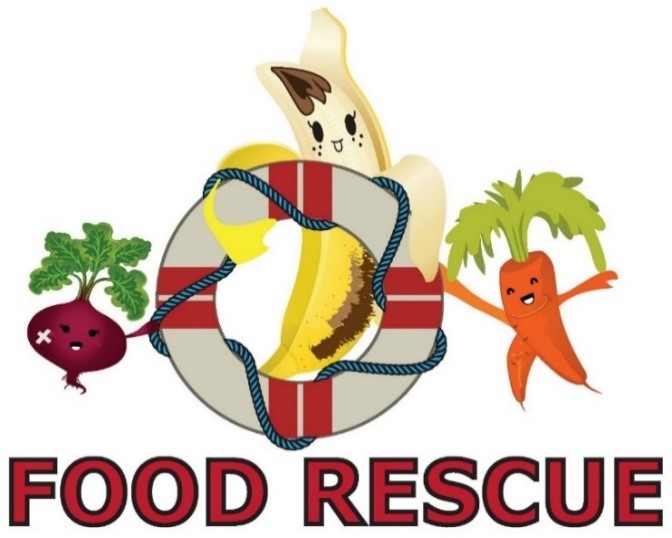
by wemakedo | Apr 10, 2017 | community, reuse |
Can you believe that estimates suggest that we are throwing away something like 30 to 40% of the food we produce globally! Amazing, when you consider the efforts that go into the use of chemicals and methods to enhance crop yields in order to boost production. It seems that there is way more food produced than we need to feed everyone if we stopped throwing so much of it away.
We wanted to share our experience with food waste reduction and our very first Food Rescue event!
As we’ve shown here, we started paying attention to our plastic waste and one thing leads to another and now we’re starting to keep a close eye on our food waste at home too. With 3 kids this can get out of control if one isn’t paying attention and it all part of wider intention to reduce our own waste and impact as much as we can.
Mrs Makedo recently became chairperson on the local primary school parents committee which our eldest girl attends. The main job at hand is to raise funds for the school. Traditional routes for fundraising seem to be hitting up businesses for raffle prizes, hitting up the locals for raffle tickets and hanging around outside the local church with a sign to hit up the churchgoers. These methods have been tried and tested and still work, but some new approaches could help the energy levels all round.
In a nice convergence of our waste philosophy and the need to raise funds for this new role, we got down to planning our first Food Rescue to raise some funds for the school.
If you haven’t heard, a Food Rescue is an initiative by Voice Ireland, an environmental group based in Dublin who ran the popular Feeding the 5000 Event. These events sprang from an acknowledgement of the huge volumes of food waste we generate. In particular food sellers are obliged to remove produce that is beyond the best- before date, but which is still perfectly fit for consumption. Similarly, funny looking veggies that are deemed too ugly to sell (in our world where appearance means a lot) can be rescued from the bin. Organizing an event where this food is rescued and used to cook up a tasty meal and bring people together to share it is known as a “Food Rescue”. And its purpose is to highlight the issue of food waste while using up some fine unloved produce to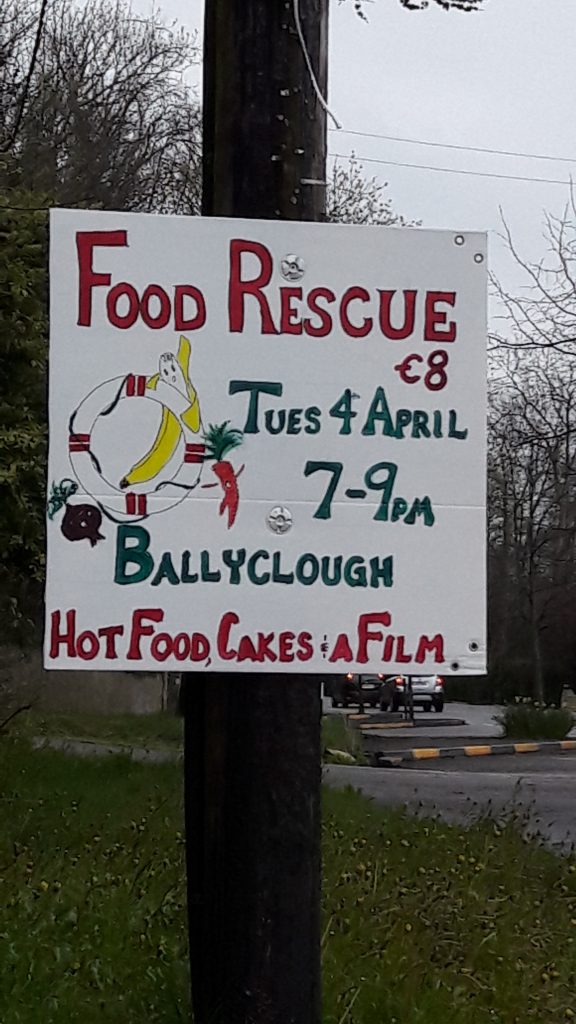 demonstrate it.
demonstrate it.
Mrs Wemakedo worked with Voice Ireland and put in several weeks of planning for the event which was held in our local community Hall on April 4th. A local high end restaurant chef (from Longueville House) was recruited to do the food preparation before the event. And we spent a few evenings handpainting some signs for advertising.
We did lots of cold calling supermarkets to see what sort of waste they have and how they could help, until we figured out that Food.Cloud have got this whole process streamlined to perfection. They have an extensive network throughout Ireland and have connected to all the supermarket chains to collect waste and find ways to use it through charities.
We found when we contacted them that they were ready to help in any way. They can source almost any kind of food at short notice and deliver to you for cooking – fantastic! Lots of successful Rescue events have been organized across the country for many years now so it’s a brisk business and one that appears to be having a great impact. People seem to know about this supermarket waste issue now. Household waste is a more personal problem and one that we can all probably do better with.
To add some variety to the event we included a viewing of the movie “Just eat it”. A very entertaining documentary about a couple who opted to live on waste food for 6 months, only spent $200 on food over that period and rescued about $20,000 from dumpsters. It has some very funny moments and is well worth a watch! We had a great response to this and people were very happy to sit through the 50 minute version. 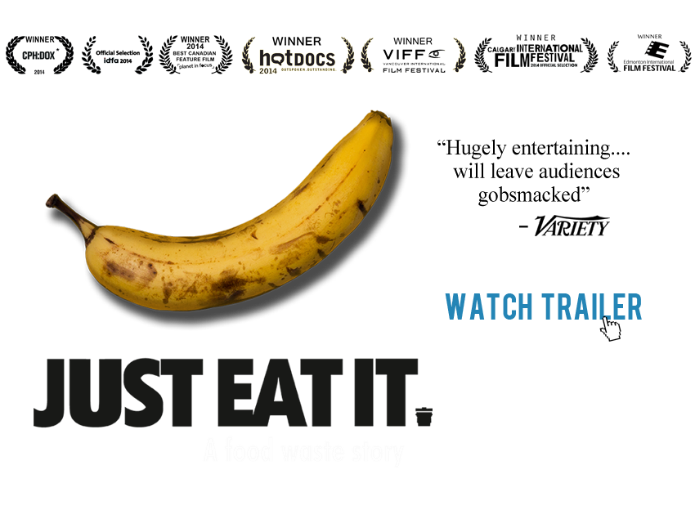
We also invited local composting expert Donal O’Leary from www.stopfoodwaste.ie along to talk to people about how to use food waste in beneficial way through composting it for your garden. He spent 30 minutes explaining all the reasons why keeping food out of landfill is important and the tricks to make it work for your garden.
The night went off really well.
Tons of super volunteers cooked cakes, provided tea/coffee to accompany the (rescued) main course and dessert and helped out with serving and clearing up. We had rescued biscuits, cheese and crisps also laid on. With an €8 charge on the door, the night attracted 80 or so guests and €600 euros was raised to help the school. We even had 2 couples attending who wanted to organize their own Food Rescues.
The Rescue idea has huge potential and with this first trial run, the hope is to make it an annual event. We were a little cautious with the food this first time round, but having seen how it all works and the excellent message it gives, we would hope to go much further with the rescued food on offer in future.
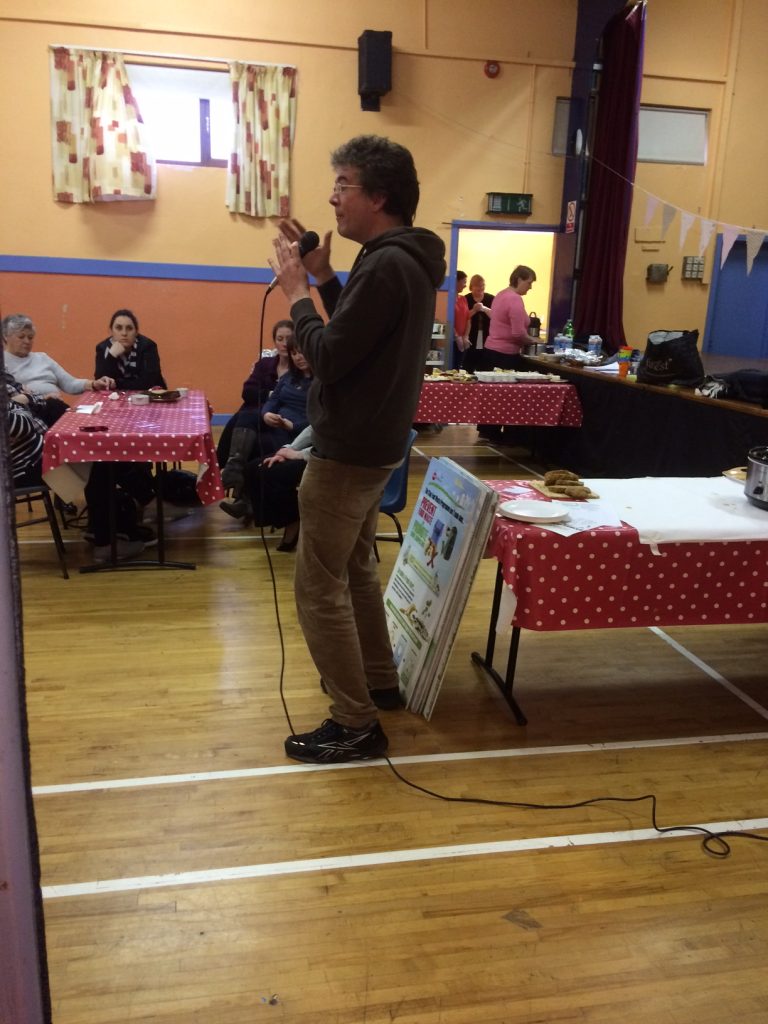
Donal O’Leary from www.stopfood waste discussing composting.
We were so busy on the night that we only took 1 picture. Here it is!
And if you’d like to organize your own Food Rescue, simply contact Mindy or Meaghan from Voice Ireland, and they’ll send you everything you need to get started!
Here are some interesting points about global food waste: (source – www.foodtank.com)
- 3 billion tons of food are wasted every year
- If wasted food was a country, it would be the third largest producer of carbon dioxide in the world, after the United States and China
- Just one quarter of all wasted food could feed the 795 million undernourished people around the world who suffer from hunger
- Food waste in rich countries (222 million tons) is approximately equivalent to all of the food produced in Sub-Saharan Africa (230 million tons)
- A European or North American consumer wastes almost 100 kilograms of food annually, which is more than his or her weight (70 kilograms)
- A European or North American consumer wastes 15 times more food than a typical African consumer
- Food waste in Europe alone could feed 200 million hungry people
Some related links:
www.voiceireland.org
http://www.stopfoodwaste.ie/
www.food.cloud/
by wemakedo | Feb 20, 2017 | health |
Home water quality is important and for us it was an issue.
When we first built our house back in 2010 we opted for installing a well on our property as connecting to the local water mains was just too expensive – it was too far from our house to connect in at a reasonable cost. Plus the idea of having control over our own supply was in keeping with our self-sufficient approach.
When the well was sunk to a depth of 200ft we felt happy that the drainage through that amount of ground would do a good job of filtering 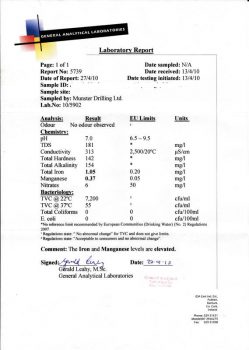 out any nasty stuff that the local landowners might want to dump on the land.
out any nasty stuff that the local landowners might want to dump on the land.
Unfortunately we were in an Iron rich area and so the water, although quite drinkable and clear had a relatively high iron and Mn content and also elevated hardness. Iron is classified as a secondary contaminant as it is does not impact health but is more a cosmetic and taste issue. When drinking a glass of water tastes like you have a bloody lip, then you just tend to avoid it!
On the advice or our plumber at the time, we went with some large passive filters to clean it up. This triple filter system (shown), used a first stage sediment mesh filter to remove particulates, a second stage carbon filter to remove contaminants by chemical adsorption and finally a third stage filter designed to remove Iron(Fe) and manganese (Mn).
 According to the supplier of the cartridges, which cost about Euros200 to replace, they should last up to a year for a house of 5 with typical consumption. Unfortunately for us we found that the problems with iron staining of our sinks, toilets and clothes never quite went away. In contrast, the hardness (Calcium carbonate) wasn’t much of an issue as it was not very high and it also adds a crisp freshness to the water flavor.
According to the supplier of the cartridges, which cost about Euros200 to replace, they should last up to a year for a house of 5 with typical consumption. Unfortunately for us we found that the problems with iron staining of our sinks, toilets and clothes never quite went away. In contrast, the hardness (Calcium carbonate) wasn’t much of an issue as it was not very high and it also adds a crisp freshness to the water flavor.
The carbon and sediment filters we installed appeared to be doing their job, but the iron filter simply wasn’t up to the task. On doing some research it seems there are different varieties of iron contamination in Irish water.
Water that comes out of the tap clear, but turns red or brown after standing contains “ferrous” iron. Water which is red or yellow when first drawn is “ferric” iron. Iron can form compounds with naturally occurring acids, and exist as “organic” iron. Organic iron is usually yellow or brown, but may be colorless. For the chemists: ferrous indicates Iron in a +2 oxidation state while ferric is iron in a +3 oxidation state. As far as we could tell, we had ferrous iron and the most commonly recommended way to remove it is by using a water softener (ion exchange resin based).
The presence of Mn will tend to create some black stains, and can give the water a bit of a bad smell, making your glass of water with meals even less appealing than the iron already makes it. Although both iron and manganese are harmless to health at these levels (1ppm and 0.37 ppm respectively), their combination in drinking water is a real problem – in that you won’t want to drink it. This is a bad situation with kids when you want to encourage to drink lots of water and less of the sugary alternatives.
When one goes looking for solutions, there seems to be much scaremongering about how specialized the water cleaning technology is. On making enquiries, we kept hearing that one daren’t make a purchasing decision without talking to “the experts” who want to sell you their specialized system that is perfect for your needs.
We received quotes from €900 to €1500 for a softener/ion exchange unit to fix our problem! Significantly more than we expected to pay for technology that seems really quite simple.
As with many other household technologies, the amount of available information online is helping to address the lack of information which forces buyers to be cornered into paying high prices. This is the rather excellent leveling effect of free information.
Armed with the knowledge that we had ferrous iron and manganese to remove as well as some hardness, we were able to avoid that first costly barrier of not knowing what we needed. That ignorance can unfortunately lead to some businesses taking advantage of those who come with a “can you understand and fix my problem for me” approach.
We found these guys (www.water2buy.ie) offered a high quality product and service designed for those willing to handle some of the leg work. Having spotted a sale price earlier in our searches, when we went back to finally make a purchase, that sale price was gone, but we were delighted that they were open to negotiation and in the end we got our new system delivered for €450 instead of the advertised €600. A whole lot less than our first enquiries forecasted.
The people at Water2buy.ie were able to assess our water analysis test results to confirm that this particular ion exchange resin would fix our problems which turned out to be correct. In the back of my mind I knew that once you have the hardware (a sealed cylinder, valves and plumping) that changing this particular resin for another option is relatively easy should there be issues later. So we felt quite happy to purchase without b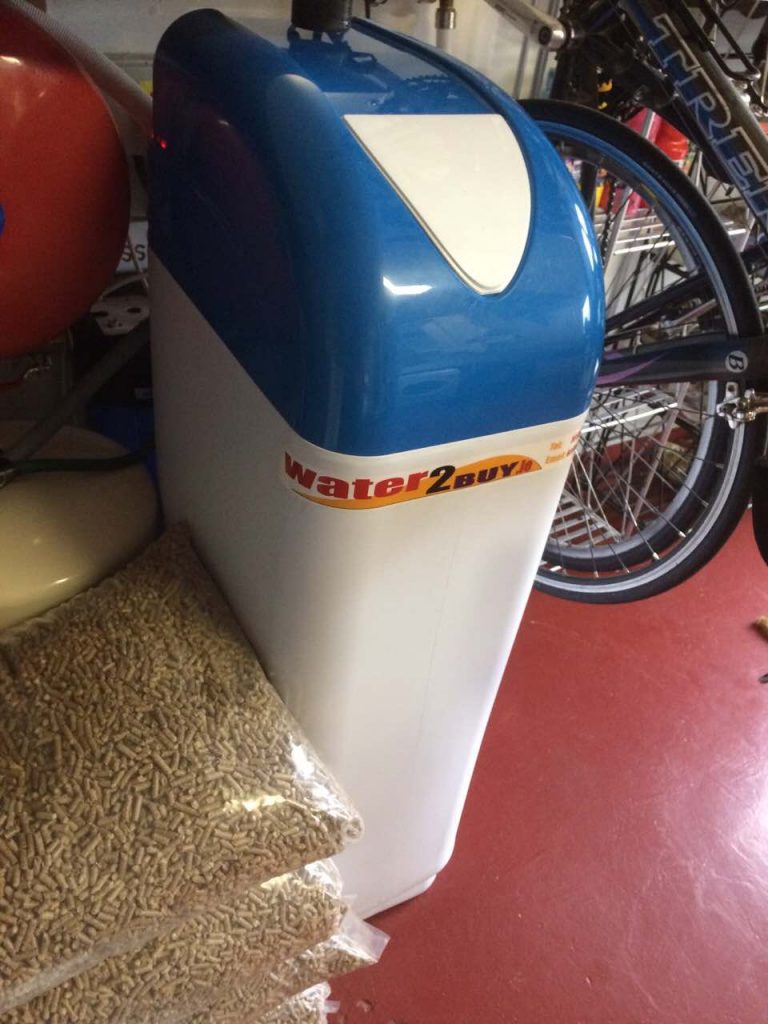 eing able to confirm that it would do the job.
eing able to confirm that it would do the job.
It turned out to be one of those rare completely successful fixes! We are thoroughly satisfied and are iron/manganese/lime free after 1.5 years of running now. As with all ion exchange processes the ions being exchanges with the unwanted contaminants need to be replenished – usually with rock salt. Through use of low flow fittings/toilets throughout our house we are down to approximately 1 x 20kg bag every 2 months. We didn’t opt for the more expensive flow based meter to set the flushing frequency, and instead went for the time based meter which just flushes at preset times regardless of the consumption. With some tweaking we managed to get it down to the point where it’s just enough to maintain the resin and so not much salt is being wasted.
The installation was easy and cost €80 with a local plumber to fit the additional lines to put the filter inline and also allow a bypass for when we needed to work on it.
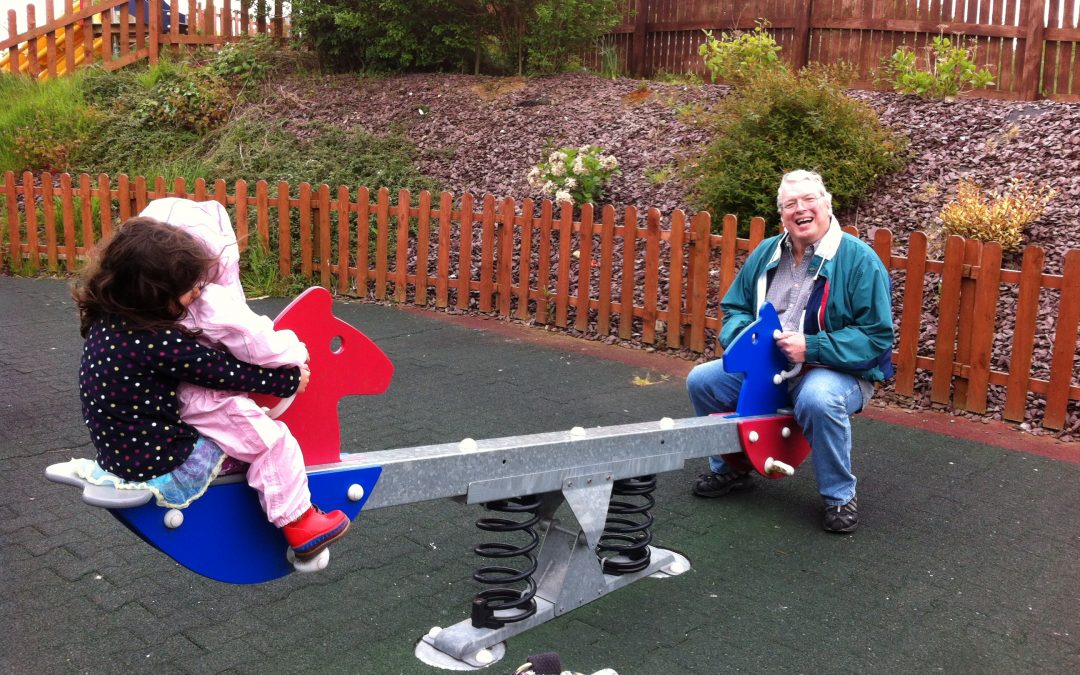
by wemakedo | Feb 4, 2017 | family |
The WeMakeDo family spent the Christmas period in Arizona this year. But unlike other family holidays, this one had a defined but very daunting purpose to it: To clear out Grandpa and Grandma MakeDo’s house of the past 40 years, to sell it and get them moved up to the Northwest to be closer to grandkids. What started as a challenging but seemingly attainable goal turned into a heart breaking experience, so poignant in its irony, that we feel it has to be shared for the message it conveys so clearly.
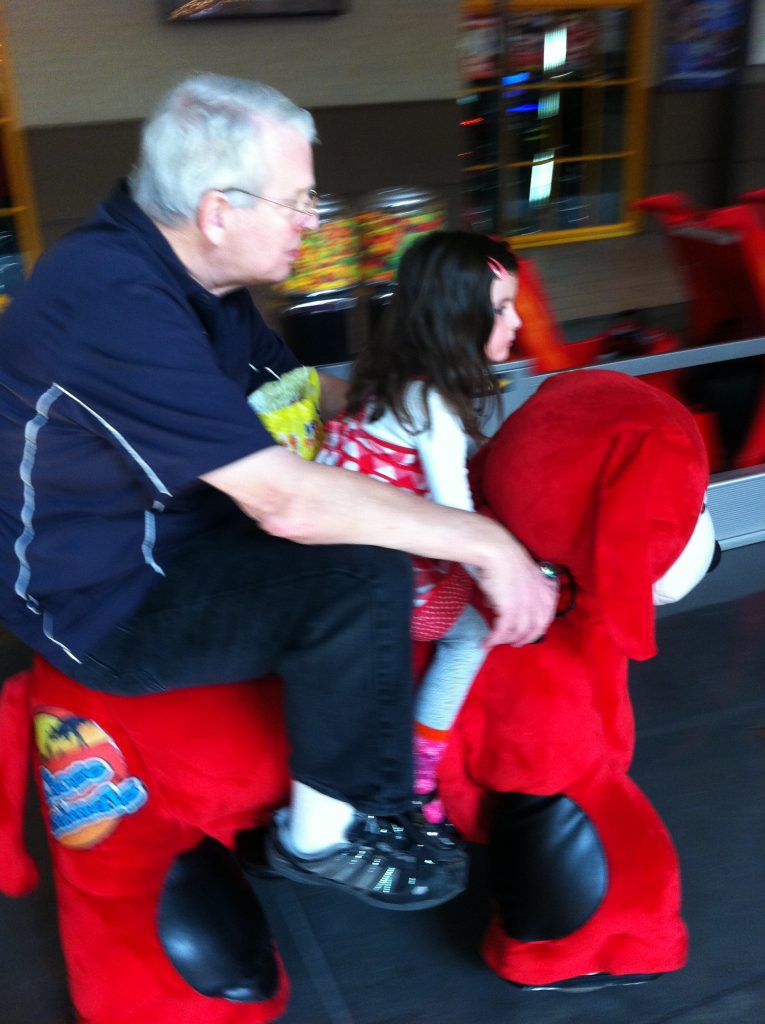 Grandpa MakeDo was the best Grandpa ever, with endless time and love for his grandkids. His lifetime dream was to live surrounded by his family – he used to use the phrase “family compound”, with the grandkids running freely between houses. But, 20 years on, they had somehow found themselves with kids gone and without much of a community around them. Elder isolation had crept in, and their quality of life was diminishing. When Mrs MakeDo would describe our set-up in Ireland to them, with the kids running over to their Nana’s house, Grandpa in particular would smile in envy. How lucky he said their Irish Grandma was, to have the kids and grandkids so near. In the US, unfortunately, most of us don’t live like this.
Grandpa MakeDo was the best Grandpa ever, with endless time and love for his grandkids. His lifetime dream was to live surrounded by his family – he used to use the phrase “family compound”, with the grandkids running freely between houses. But, 20 years on, they had somehow found themselves with kids gone and without much of a community around them. Elder isolation had crept in, and their quality of life was diminishing. When Mrs MakeDo would describe our set-up in Ireland to them, with the kids running over to their Nana’s house, Grandpa in particular would smile in envy. How lucky he said their Irish Grandma was, to have the kids and grandkids so near. In the US, unfortunately, most of us don’t live like this.
So the extended family came up with a plan. We’ll move Grandpa and Grandma up to the Pacific Northwest, where 8 members of the family were, including 3 grandkids. And then we’ll work on getting them a visa to live in Ireland, once the Washington family have had enough! Then Grandpa MakeDo’s life dream could finally come true.
That plan was hatched about 2 years ago and unfortunately never took off….
The problem was, Grandpa was a little bit of a hoarder. He loved electronics, and woodworking, and airplanes, and BOOKS! Piles of books that hadn’t been looked at in years. And every kind of tool imaginable. Coffee cans of screws and nails that ‘could be useful someday’. Furniture from his great grandma, and special cherrywood that he’d planned to build a desk out of in 1972. He couldn’t bear to part with any of it. His hobbies and passion for learning was what made him interesting and wonderful. But unfortunately, that’s also what prevented him and Grandma from selling the house and moving closer to family.
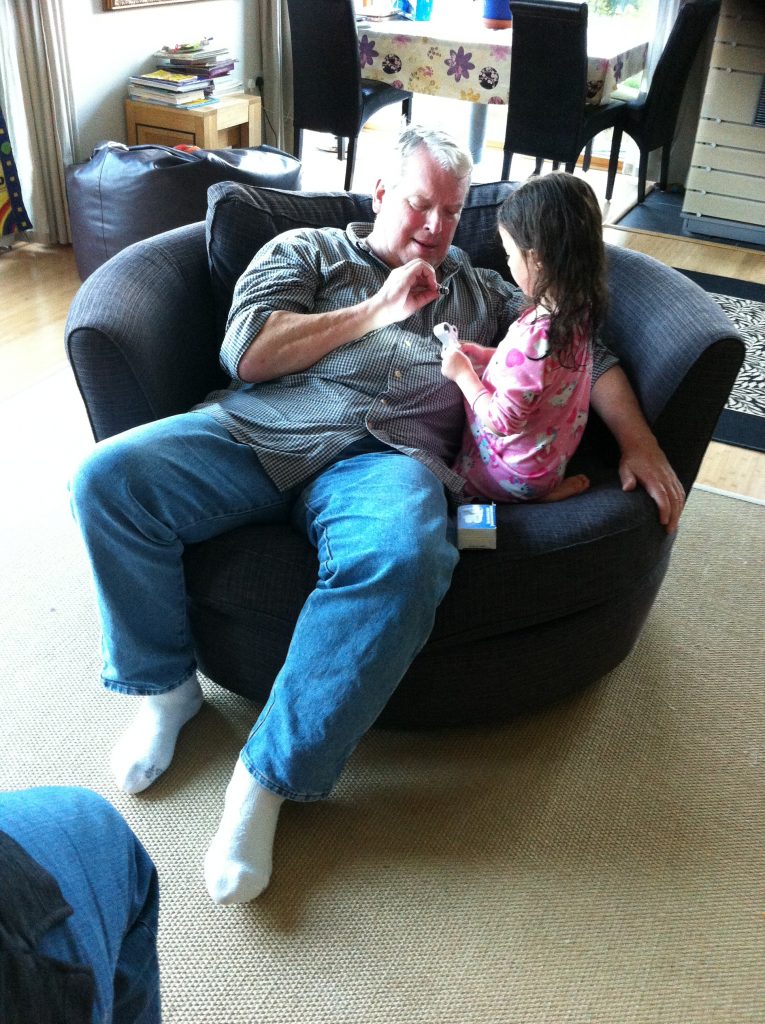 So, with a nagging feeling that time was of the essence, round 2 of the plan was devised and approved by all family. We (Mr & Mrs MakeDo) would come to Arizona to do the ugly work: Pry the possessions from a now fragile Grandpa MakeDo, by distracting him with the company of his grandkids. It worked beautifully, and after working nearly 10 hours a day for 3 weeks (a blog post for another day about the joys of dispositioning heaps of stuff to numerous amazing charities, and the wonderful support of friends and family who pulled together to support this effort), we decided we’d finished. So we rewarded ourselves by driving up to the mountains for a 2 day holiday-within-a-holiday.
So, with a nagging feeling that time was of the essence, round 2 of the plan was devised and approved by all family. We (Mr & Mrs MakeDo) would come to Arizona to do the ugly work: Pry the possessions from a now fragile Grandpa MakeDo, by distracting him with the company of his grandkids. It worked beautifully, and after working nearly 10 hours a day for 3 weeks (a blog post for another day about the joys of dispositioning heaps of stuff to numerous amazing charities, and the wonderful support of friends and family who pulled together to support this effort), we decided we’d finished. So we rewarded ourselves by driving up to the mountains for a 2 day holiday-within-a-holiday.
We arrived back to find that Grandpa had just been taken to hospital after collapsing at a doctor’s appointment. The next day was our eldest child’s 6th birthday, which we planned to celebrate by sneaking the kids and chocolate cake & candles into Grandpa’s hospital room. When we got there, he was not in any shape for celebrating. His last words were a warm Happy Birthday to our eldest, and telling them how much he loved them as he hugged them. And a few days later, he was gone.
The fist pounding, frustrating, horrible irony of this all is that his stuff prevented him from realizing his lifelong dream. This plan was never able to get off the ground over the previous 2 years due to the overwhelming burden of their possessions. It was just too difficult and a source of too much contention to start to tackle the stuff that needed to be sifted through. This meant that Grandpa did not get to spend the last few years of his life around his grand kids as was his dream. And, too much of his last few weeks were taken up in dealing with stuff and what to do with it: Issues like some missing items, lost due to all the moving around that was going on…..where should things go that were just too big to take but too good to give away …what price should we ask for some tools that were too good to donate etc. etc. Surely these things we accrue during our lives do not deserve to take so much of our time as they can do especially when it is so, so precious.
We returned home heartbroken….and even more determined not to let our stuff dictate to us under any circumstances.
Apologies for the lack of communication here for a while, but we couldn’t find the words.
“Onward and upward” as Grandpa would say…
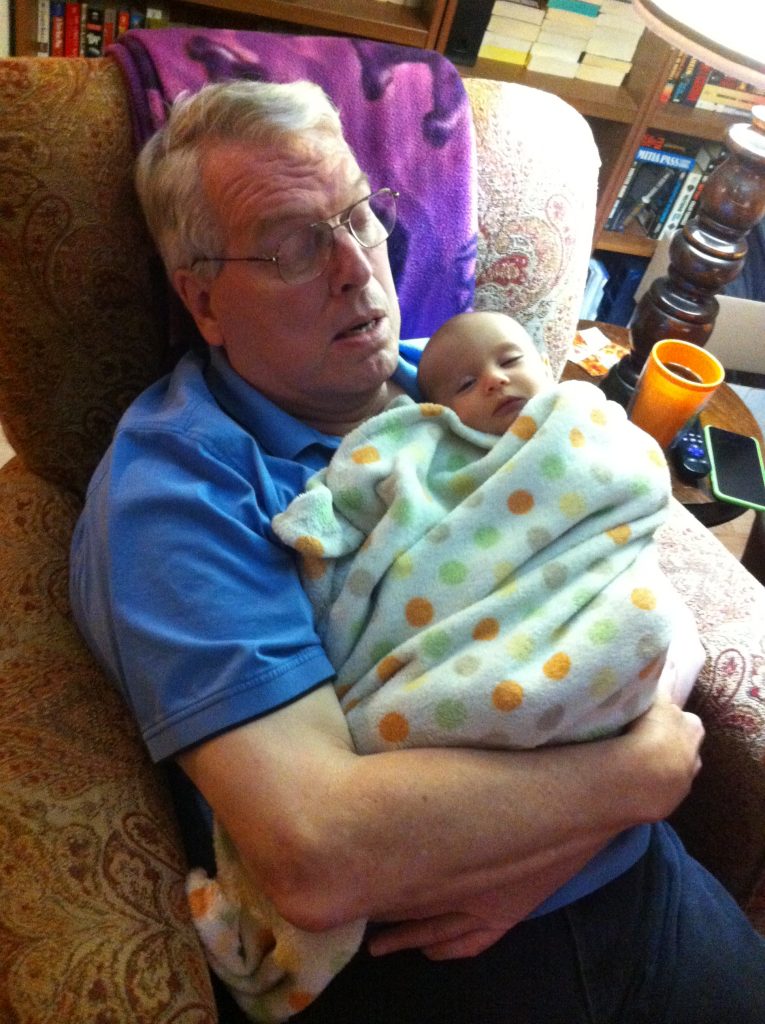
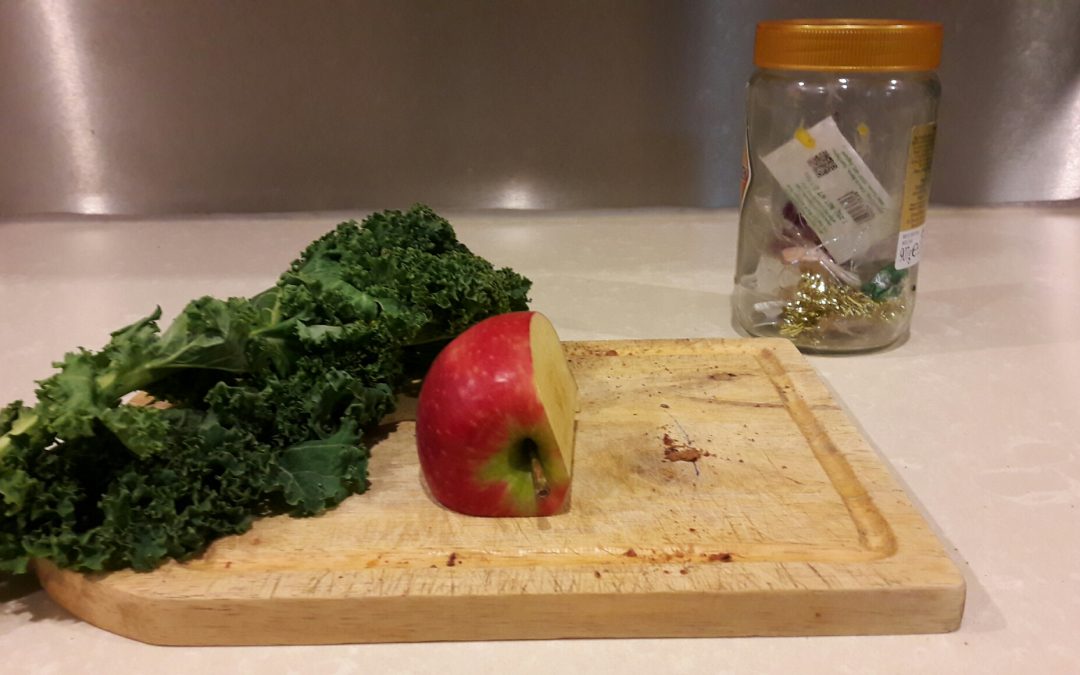
by wemakedo | Dec 3, 2016 | Plastic Free July |
It’s been a few months now since we started trying to minimize our household waste. The strange thing is that it’s been a lot easier than expected to keep ourselves at the much reduced waste level compared to where we were at initially …but very hard to progress beyond it.
We kept our glass jar on the counter as our waste bin so as to keep the focus for everyone in the house. We regularly comment on how full or empty its looking but generally speaking the half liter sized jar fills up in a week or so.
Not bad.
But then a plastic “recycling” bin crept back into use and it has a life of its own.
With kids, it seems nearly impossible to control the level of plastic coming into our house. Things like birthday parties, gifts from well-meaning friends and one-off purchases for them keep catching us out.
The Kitchen and general household stuff that goes into the glass jar/bin is well under control at this stage because we are now used to managing our regular household purchases. But there seems to be an endless stream of unusual plastic rubbish coming our way – sometime too big to fit – and so we’ve kept a larger recycling bag on the go.
Let’s focus on the positives first though. We have kept the habit of buying at farmers markets and SuperValu – still the best chain for unpackaged fruit and veg. And we have managed to maintain all our regular food related purchases at near zero waste level. Our old bin under the sink hasn’t returned, and neither have any of the other bins around the house. And we’ve gotten used to not looking for them and instead stuck with our new means of disposing of things.
For example when wiping down the table after a particularly messy meal, the stuff now goes either to composting or the chickens. Or in rare cases when cooked leftovers stay in the fridge too long and need to go, we have resorted to flushing them down the toilet. A perfectly fine option when not done too often.
For some items we still can’t find plastic /waste free alternatives and so we have done the best we could..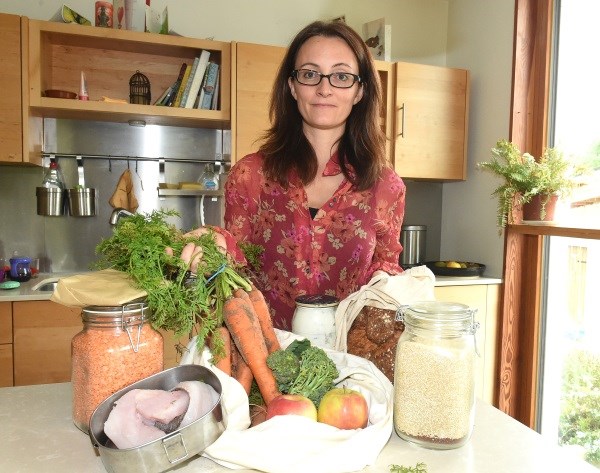
For example the raisins we now buy in large bulk (plastic) bags from Nutsinbulk. But it involves a lot less packaging waste than we used to create using the small plastic packs of raisins.
Our milk we now get mostly from “Siopa gan Ainm” on CornMarket street in Cork. They get it from a farm in Clonakilty – it costs €1.50 for a liter and you get 50 cent back when the bottle is returned.
Yoghurt and cereal are still all home-made now and the kids prefer the granola over other cereals, while porridge has always been available in paper bags. We’re looking into a possible source of large bulk bags of porridge too as we seem to burn through the stuff at a high rate – especially with granola making.
We’ve even been investing in some stainless steel containers to avoid putting the foods like fish or cheese into plastic reusable containers. One starts to feel like plastic should be avoided anywhere food is involved.
We haven’t figured out a way to source butter in some recyclable or unpackaged form.
Reusable nappies and non-disposable wipes (aka rags) has become second nature now for our youngest who has another couple of years of nappied life to go.
We bought bamboo toothbrushes, but have found that they’re not as nice to use as the regular plastic ones. This is more to do with the basic design of the bristles and their texture than the handle, but not sure if we’ll buy those again.
Shampoo bars are now second nature too for everyone in the family.
Toothpaste is still a problem.
We tried and failed to find toilet paper that isn’t wrapped in plastic too. Although we have a plan here…the use of bidet guns are the way to go. We might write about this in the future if modesty permits.
Also our composting has become a little more flexible and so some cooked foods are now going in there where we can’t figure out alternative…i.e. waste food that neither cats nor chickens would eat. So far this seems to be fine as our composters are good and big. But we’re conscious that too much may start to make the composters smell, so we won’t abuse this option.
We have taken one batch of non-recyclable waste for disposal since we started this back in May/June which is nice. This is down from what ordinarily might have been about 3 or 4 batches, but we do intend to try to improve this further
All in all making these changes, although daunting in the beginning are proving to be very easy to stick with. It feels like another push is needed to improve further – perhaps in the New Year, but we don’t seem to have slipped back into old habits and are planning to stick with this.
Our appearance in The Examiner drew a lot of feedback from our friends, and it was nice to hear of people who enjoyed the article and felt motivated to try similar efforts in their own homes. From a grandmother who’s now getting her grown daughters to shop plastic free, to another friend who asked for a shopping consultation!
Others felt that “we must have too much time on our hands” which we thought was an interesting viewpoint. In response to that, like with most things, we all have less time than we would like. Getting certain things done just means that you move things up your priority list. I.e. you will do things that you feel are most important to get done first and other things will always fall off the bottom of the list. For us, this waste problem suddenly felt very important, and how we were going to respond to it became even more important. Suddenly there was less time for watching a movie or for reading a book and more time given to making homemade granola or yoghurt or trying to find bulk raisins.

by wemakedo | Nov 11, 2016 | money |
A large part of our WeMakeDo philosophy is removing waste from our lives and building in self sufficiency where we can, mostly because of the satisfaction it brings but also because of the cost savings. We want to have a low-cost life and have set the goal for ourselves to live on 30-35k per year for our family of 5 while still living as well as we want to. This is in part so that we don’t have the constant pressure of having to make lots of money to live as we choose but more-so because it just removes a lot of the hassles from our lives that tend to come from extravagant spending. Putting it another way – breaking the cycle of needing lots of money to feed consumption habits that lead to lots of stuff and hassle that then requires more money and time to maintain.
With this approach in mind it makes a lot of sense to have your money work hard when it’s not being spent and so we have spent a lot of time and effort examining the options available to make your saved money work for you and provide some useful income
In this post we wanted to share three topics:
- A must read blog from a person in the US who has successfully designed his family lifestyle to allow him to retire at age 30 and to live how he wants on $25k per year which comes from interest on his savings if he chooses not to earn money with his time.
- 2 options you may not have heard about if you have savings that need to do some more work with a little risk.
The blog..
An online hero of ours had been writing about his life choices for over 4 years now and these choices have allowed him to retire from salaried life at age 30 with his wife and child and he is now over 12 years on this path. It’s important to note that it was never his intent to sit around and do nothing, but instead to control his finances in a way that allowed him to have the freedom to choose how he spent his time doing when not forced to follow a salary. He writes excellently about how he has achieved this through removing unnecessary spending from his life while making his saved money work, all the while leading the satisfying life that he wants to live without earning a salary. Unless one starts adopting this approach early in life, achieving his outcomes are not easy, but there is plenty to take from this philosophy of not consuming wastefully and taking control of ones finances : check out the story here www.mrmoneymoustache.com or alternatively you can watch Pete (Mr Money) describe his lifestyle at this excellent talk from the World Domination Summit.
The savings growth options..
In the current low interest times, savings are no longer a worthwhile option, as the paltry rates are nowhere close to inflation and so money in banks although somewhat protected from wasteful urges is not exactly working. The problem is that the only other way to have your savings grow is to subject them to risk at varying levels. The stock market is the most well known vehicle for putting money to work with different levels of risk involved. With global interest rates as low as they are, big investor money is chasing one of the few places to still make money through stocks which has had the effect of driving US markets to all-time highs. The US markets have returned to the peaks they reached before the crash in 2007/2008 and now fear is beginning to return as people wonder how much longer this can continue with some economies on shaky ground in places like Europe and China. One way to still take part but to minimize the risks is to buy into funds that are spread across broad areas of the market and to do this in an automated way over a longer term which aims to take advantage of the general upward trend of markets.
Roboadvisors: These are a new breed of money management companies that have simplified and automated the process of making your money work in stocks and funds with very low fees. These Robo-advisor companies will manage your money and use it to buy into funds where you specify the risk level you are happy with. They automate the process of adjusting your investments to take account of changes in the risk levels of different assets and do this rebalancing using algorithms which work without your involvement. They will also manage the reinvestment of dividends and income. The nice thing about this service is that you don’t have to spend time watching and fretting about whether it’s invested in the right place, and historical evidence has shown that if you buy in and hold over the long term, the stock markets are always going up despite crashes of varying sizes along the way. Data shows that for US markets at least, the average annual return is approximately 7% over the longer term (10% before taking account of inflation). Thus buying and holding using these automated services looks very attractive and our friend MrMoneyMoustache has plenty of data on his site showing the performance of his investments using one of the better known US Roboadvisors. The UK equivalents do pretty much the same thing. I plan on investigating these more with a view to jumping in. We’ll report back if we do.
Some noted options:
Peer to Peer (P2P) Lending: This is a relatively recent addition to the “sharing economy” and is a service which makes use of peoples willingness to lend their money to borrowers in conditions where banks might not want to lend. In some cases this can be because the borrowers are considered too risky but in other cases it may be too short duration with too high a loan to value ratio. These companies pay their lenders well for putting up with the risk. One such example I have dabbled in is : www.Savingstream.co.uk.

These guys will pay you 12% interest per year on money that is used to make up short term loans for properties and development projects. They say they have a rigorous vetting process to make sure they only take on borrowers with low risk of defaulting. But be warned: if a borrower does default, then the money you have invested which part funded this loan may be at risk, although the model allows for the sale of the asset to be used to recoup the loan for investors and since 2013 this particular company has a 100% record in repaying the loans.
It’s not a place for alot of your long term savings but certainly can be considered as an easy way to generate some very good income on savings with a reasonably low level of risk.
At some future point we will update on how our income experiment with this company is going.

 demonstrate it.
demonstrate it.

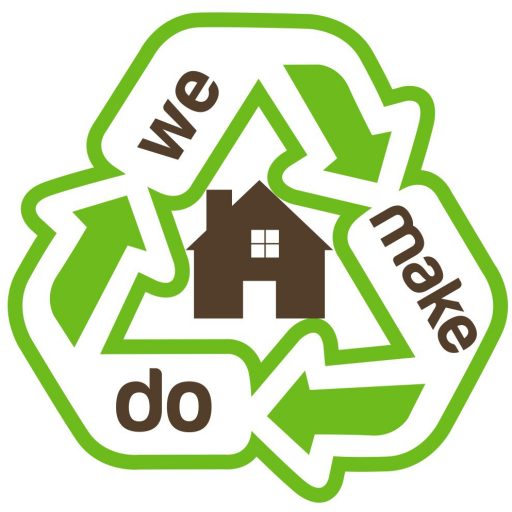





 Grandpa MakeDo was the best Grandpa ever, with endless time and love for his grandkids. His lifetime dream was to live surrounded by his family – he used to use the phrase “family compound”, with the grandkids running freely between houses. But, 20 years on, they had somehow found themselves with kids gone and without much of a community around them. Elder isolation had crept in, and their quality of life was diminishing. When Mrs MakeDo would describe our set-up in Ireland to them, with the kids running over to their Nana’s house, Grandpa in particular would smile in envy. How lucky he said their Irish Grandma was, to have the kids and grandkids so near. In the US, unfortunately, most of us don’t live like this.
Grandpa MakeDo was the best Grandpa ever, with endless time and love for his grandkids. His lifetime dream was to live surrounded by his family – he used to use the phrase “family compound”, with the grandkids running freely between houses. But, 20 years on, they had somehow found themselves with kids gone and without much of a community around them. Elder isolation had crept in, and their quality of life was diminishing. When Mrs MakeDo would describe our set-up in Ireland to them, with the kids running over to their Nana’s house, Grandpa in particular would smile in envy. How lucky he said their Irish Grandma was, to have the kids and grandkids so near. In the US, unfortunately, most of us don’t live like this.





